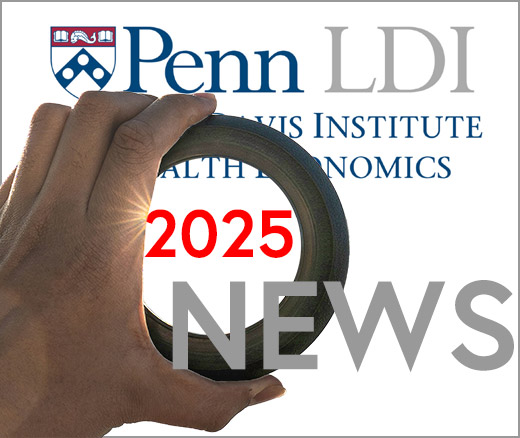
How Playing Games May Save People’s Lives
The Growing Use of Gamification in Health Motivates People to Exercise More and Take Other Actions to Improve Their Physical Well-Being
Substance Use Disorder
News | Video
Although it was titled “Front Lines of the Fentanyl Crisis,” the May 23 U.S. Senate Committee on Finance hearing featuring the testimony of LDI Senior Fellow and University of Pennsylvania Professor Jeanmarie Perrone, MD, included a lot of questions about the xylazine crisis.
Perrone, a Professor of Emergency Medicine at the Perelman School of Medicine and Director of the Penn Center for Addiction Medicine and Policy, is one of the country’s foremost experts in the field of opioid dependence treatment. She was invited to address senators’ questions about the rapidly rising dangers of fentanyl contamination across the street drug supply and the further expansion of the telehealth and video conferencing models to reach more substance users in need of treatment.
But, apparently responding to the Drug Enforcement Administration (DEA) April alert that “Xylazine is making the deadliest drug threat our country has ever faced, fentanyl, even deadlier,” Committee Ranking Member Sen. Mike Crapo (R-ID), Sen. Chuck Grassley (R-IA), and Sen. Thomas Carper (D-DE) asked Perrone if new measures or new pharmaceutical antidotes were needed to address the rising xylazine crisis.

Xylazine is an animal sedative and muscle relaxant that is substantially easier to acquire than heroin or fentanyl. By mixing in Xylazine, drug dealers can increase the volume of their product at a lower cost, thereby maximizing their profit margins. In humans, xylazine has been associated with the development of skin wounds, both at the injection sites and distant from injection sites, and in people who use drugs through the nose.
Perrone noted that as in other cities across the country, the fentanyl supply in Philadelphia has been widely adulterated with xylazine, which is known on the street as “tranq.”
“We’re seeing different kinds of wounds with xylazine and these wounds on patients who are housing challenged fester and progress so that when the person finally comes to the emergency department (ED) because of the wounds, they need to be hospitalized,” Perrone said. “After hospitalization it’s very difficult to send them to most rehabilitation facilities because those facilities can’t accept patients with wounds. That’s a big catch 22 limiting our ability to get the most vulnerable patients who need help the most into treatment.”
“However,” Perrone continued, “I don’t want to misguide this Committee. Our deadliest drug is fentanyl. Fentanyl stops people from breathing, and all the xylazine on the street is accompanied by fentanyl. So, we still have naloxone that reverses the fentanyl component. Revived patients may still be sleepy, but they’re breathing. So, I want to keep the focus on fentanyl as the most important drug we need to be thinking about. We have one antidote that works incredibly effectively. We don’t need ten antidotes. I don’t want to be distracted by all these other drugs coming into the drug supply, because it’s really mixed with fentanyl. And fentanyl is the deadliest component of all of this.”
Perrone, who was questioned by 11 senators during the two-and-a-half-hour hearing, oversees two Penn Medicine “low barrier” addiction treatment initiatives. One is the Emergency Department, and the other is the CareConnect Warmline telehealth program. Both are designed to provide rapid same-day response and initial medication treatment for patients with opioid use disorder (OUD) seeking care.
The ED clinicians and nurses have been trained in the use of medications for opioid use disorder (MOUD). During their first visit, patients with OUD can receive their first dose of suboxone or methadone. And they can leave with a prescription for suboxone and a personal link to the CareConnect Warmline telehealth for follow up transitions. The system also connects the patient with the program’s “peer” support personnel and substance use navigators. Part of the treatment team, peers are people in recovery from OUD who provide empathetic and experience-based support and guidance to patients seeking recovery. Substance use navigators help patients locate support resources and follow-up appointments with clinics in their areas.
Perrone explained: “‘Low barrier’ treatment means that the patient doesn’t need an insurance card and doesn’t need to wait weeks for an appointment or to be subjected to various scrutinies, all of which can derail early attempts at recovery. Multiple randomized controlled studies have built the evidence demonstrating that treatment with these MOUDs can reduce the risk of fatal overdose by 65%. Yet only 11% of people with opioid use disorder receive these medications. Appointments, insurance, transportation, and pharmacies stand in the way,” said Perrone.
Citing a recent example of one of her own patients, Perrone noted that even after the patient received a prescription for buprenorphine on her first visit, pharmacies declined to fill it.

“This patient was from another county,” said Perrone. “The pharmacists said things like ‘You’re not in our system,’ or ‘You’ve never filled a prescription here before.’ These pharmacy barriers aren’t being touched on in today’s hearing, but they represent a tremendous stigma and impediment. Pharmacists are driven by their fear related to what happened in the opioid crisis with the overprescribing of opioids. We need to mitigate this barrier for OUD patients.”
Another topic of the hearing was the telehealth prescription and treatment system that Perrone’s and other OUD treatment programs across the country are now using. The relaxation of the rules governing prescribing suboxone via telehealth systems rather than mandatory in-person visits was part of the early 2020 COVID-19 Pandemic Public Health Emergency Declaration. The final portions of that temporary rule change expire this November.
Committee member Sen. Sheldon Whitehouse (D-RI), who is one of 29 senators working on a bill to make the emergency rule changes permanent, asked Perrone, “Is there any upside to letting the telehealth authorization expire?”
“No,” said Perrone. “Telehealth has created a critical addiction safety net that is more cost effective than the emergency department, and more patient-centered than other care settings. Our Care Connect Warmline program offers free telehealth, substance use navigation, and same day clinician appointments to start treatment with suboxone. We leveraged our peer-led model to staff 9 a.m. to 9 p.m. seven days a week. We have now treated over 2,000 patients. That includes 10% of them released from incarceration in the past 30 days.”
“Implementing this important safety net for formerly incarcerated citizens reentering the community mitigates this high-risk period and is critical to closing the treatment gap that patients face when they leave carceral settings,” Perrone continued. “We have also expanded other services for this vulnerable population, including assistance navigating insurance applications, phones, and transportation to future appointments.”
Perrone pointed to the Health Resources & Services Administration’s (HRSA) Ryan White funding model that she said could be used to establish regional networks of telehealth addiction bridge treatment centers much like Penn’s that would prevent gaps in care and continue OUD patient medication during care transitions.
Enacted in 1990, the Ryan White HIV/AIDS Program is federally funded to serve as a safety net for people with HIV. It covers care, treatment, and support services to those without health insurance and fills in the gaps and costs for those with only limited insurance. In 2022, the program was funded by Congress for $2.5 billion as part of the Department of Health and Human Services’ (HHS) “Ending the HIV Epidemic” initiative that hopes to reduce new HIV infections by 75% in five years and by 90% in 10 years.
“Two-thirds of our telehealth patients were recently on suboxone yet were discharged from a care setting without a timely follow up or had lost insurance, or faced a life event where their care was disrupted,” said Perrone. “Experiencing opioid cravings without medications drives patients back to the street, only to face the most lethal street drug supply and potentially overdose.”
“Telehealth can help establish substance use care with privacy, and then transition patients to a primary care integrated model, where they receive their addiction care along with their hypertension and diabetes medication, all from one trusted provider,” Perrone told the Committee. “Our patients transition from our ED or telehealth visits to Penn primary care practices. This integrated model needs to be expanded and reimbursed to sustain discreet treatment options. This requires investment in clinician workforce, including expanding addiction medicine training and graduate medical education, and support for expanding capacity for more trainees for addiction medicine fellowships.”


The Growing Use of Gamification in Health Motivates People to Exercise More and Take Other Actions to Improve Their Physical Well-Being

Pa.’s New Bipartisan Tax Credit is Designed to be Simple and Refundable – Reflecting Core Points From Penn LDI Researchers Who Briefed State Leaders

Focusing in on Some of Health Care Policy’s Most Urgent Issues

Highlighting 10 Ways LDI Fellows Put Their Research Into Action

From AI-Powered Public Health Messaging to Stark Divides in Child Wellness and Medicaid Access, LDI Experts Highlight Urgent Problems and Compelling Solutions

An LDI Expert Offers Three Recommendations That Address Core Criticisms of the ACA’s Model